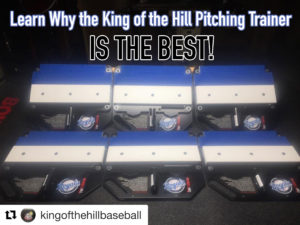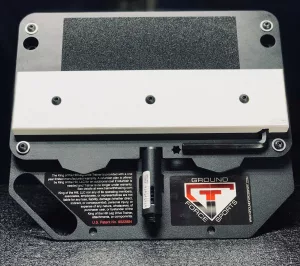 In the instructional world of baseball biomechanics, pitching trainer s are always extremely popular. It is obvious it is a lot more desirable to purchase a product that claims to give you results with little effort of learning or training over methods that require hard work and long hours. The problem is these devices are always claiming they are worth a lot more than they are. I never liked the concept of training devices, are what I usually call gimmicks, probably because I grew up in the era of the beginning of infomercials and products like the Thigh Master. It always seemed like a shortcut to a challenging problem like losing weight or making money.
In the instructional world of baseball biomechanics, pitching trainer s are always extremely popular. It is obvious it is a lot more desirable to purchase a product that claims to give you results with little effort of learning or training over methods that require hard work and long hours. The problem is these devices are always claiming they are worth a lot more than they are. I never liked the concept of training devices, are what I usually call gimmicks, probably because I grew up in the era of the beginning of infomercials and products like the Thigh Master. It always seemed like a shortcut to a challenging problem like losing weight or making money.
I finally gave in and tried one of these pitching trainers in baseball mainly because something about this device was different. The device also gave me augmented feedback of the knowledge of performance not the knowledge of results. A radar gun or all the single sensor output speed units currently trending in baseball are the common devices to give augmented feedback of the knowledge of results (Magill & Anderson, 2017). My clients come to me to help them get better results and the source of the problem is in the performance.
Why Purchase King of the Hill Pitching Trainer
 One of my favorite devices for receiving augmented feedback on the knowledge of performance is called the King of the Hill Pitching Trainer. I was introduced to the pitching trainer when it was just about to be launched by Rich Dunno the developer. This device is an auditory feedback tool for the pitcher to know when he is generating enough linear drive leg force to make the plate he is driving into the pitching rubber pop or bang. This sound tells the pitcher they initiated a good back leg drive and when it occurred. The problem with training the back-leg drive in the pitching delivery is that the task-intrinsic feedback is very poor. It is extremely hard to get a clear sense of your biomechanics of the drive leg in the pitching delivery. More than likely because pitching is such a complex movement so many body parts are going off at once.
One of my favorite devices for receiving augmented feedback on the knowledge of performance is called the King of the Hill Pitching Trainer. I was introduced to the pitching trainer when it was just about to be launched by Rich Dunno the developer. This device is an auditory feedback tool for the pitcher to know when he is generating enough linear drive leg force to make the plate he is driving into the pitching rubber pop or bang. This sound tells the pitcher they initiated a good back leg drive and when it occurred. The problem with training the back-leg drive in the pitching delivery is that the task-intrinsic feedback is very poor. It is extremely hard to get a clear sense of your biomechanics of the drive leg in the pitching delivery. More than likely because pitching is such a complex movement so many body parts are going off at once.
The moment I was sold on the device and immediately promoted it with my training programs for pitchers was when I implemented it in with my camps. I quickly noticed I didn’t have to provide much if any descriptive feedback of the drive leg actions I was having the campers train. Descriptive feedback describes the errors of the performance. Studies have found that this type of augmented feedback is beneficial for skill transfer and reduces the risk of injury (Myer et al., 2013). It was the ideal tool to challenge them to improve the lower half without overloading them with descriptive feedback. This is when I realized this device was much more than a gimmick, it was a better coach than I!
The challenge is once the pitcher has spent a good amount of time on the device the improvements grow smaller as the pitcher develops more ability to enhance the dynamics of the lower half. This is when I like to bring in more quantitative and qualitative augmented feedback. As for quantitative feedback, I will sometimes use a force plate to give them not only a numerical value to the level of their drive but also the relationship of this force production to the front leg force production. This helps them learn how to transfer and increase forces from drive leg to front leg. Once they start to influence these readings I will use qualitative feedback to help them understand how well they are improving the movements.
Video Analysis Great Addition to the King of the Hill
My favorite form of quantitative and qualitative augmented feedback is using video analysis. iPhone apps like Hudl Technique and Coaches Eye are great tools for giving augmented feedback. These tools have measuring devices like for measuring angles and time. They also make it great ways to compare one athlete to the other which is a good way to introduce beginner athletes to video analysis. It works great for beginner athletes by comparing them to the “gold standard,” especially when the “gold standard” is someone they look up to or idealize. Evidence suggests that video modeling is a great way to learn when there are many different examples of information to learn from (Moore, & Fisher, 2007). The only issue I find with video analysis hindering learning is if they are overloaded with information. This is when I resort back to the simple training devices.
I have a new app that includes multiple Bluetooth sensors to capture 3D motion. It is video analysis for scientists. It has many more measuring tools for measuring speed, angles and kinematic sequencing. It is the ultimate format for quantitative augmented feedback. The problem is it is very overwhelming for the beginner athlete. I only use this technology for my more advanced athletes who have had the time to learn biomechanics and its terminology.
Checkout the King of the Hill with the 3X Velocity Development Kit
King of the Hill Pitching Trainer Reference
Magill, R. A., & Anderson, D. I. (2017). Motor learning and control: Concepts and applications (11th ed.). New York, NY: McGraw Hill.
Moore, J. W., & Fisher, W. W. (2007). The effects of videotape modeling on staff acquisition of functional analysis methodology. Journal of Applied Behavior Analysis, 40(1), 197–202.
Myer, G. D., Stroube, B. W., DiCesare, C. A., Brent, J. L., Ford, K. R., Heidt, R. S. Jr., & Hewett, T. E. (2013). Augmented feedback supports skill transfer and reduces high-risk injury landing mechanics: a double-blind, randomized controlled laboratory study. American Journal of Sports Medicine, 41(3):669-77.


Interested to find out what happened with my purchase